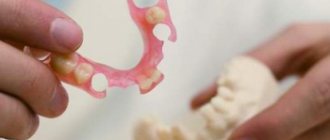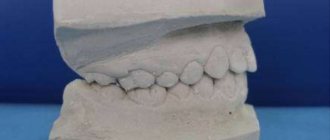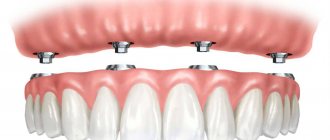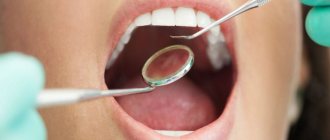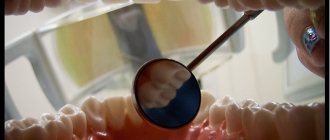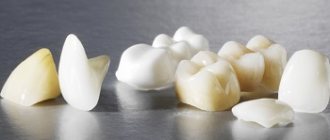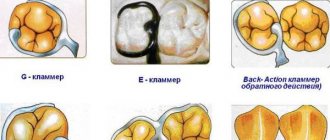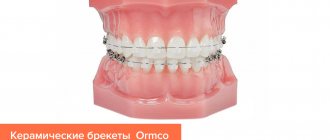1775
Many patients explain their refusal to undergo restoration through prosthetics by the need to wear “non-native crowns” in their mouth for a certain time and endure the painful procedure of grinding down tooth enamel.
Today, physical discomfort can be minimized with the help of modern dental restoration techniques, one of which will be discussed in this article.
General overview
CAD CAM is a unique modern technology for the production of dental prosthetic products using panoramic 3D computer modeling and further production of the prosthesis using electronic milling equipment.
The technique is fundamentally different from standard manual production technologies with higher accuracy of finished products, speed of production and ease of use.
The procedure includes the following steps:
- diagnostics using a computer;
- panoramic system modeling;
- prosthesis production;
- installation of the structure.
The main goal of CAD CAM is the processing of high-strength materials and the production of high-quality prosthetic structures that do not cause discomfort and have high aesthetic characteristics.
Hybrid ceramics VITA ENAMIC
VITA ENAMIC is the world's first dental hybrid ceramic with a double mesh structure.
The dominant ceramic mesh structure in the material (86%) is reinforced by a polymer mesh structure (14%), and both of these structures are completely interpenetrable. Thanks to this, VITA ENAMIC, a dental hybrid material, combines the advantages of both ceramics and composites. This innovative hybrid material, in addition to its excellent resistance to stress, also has exceptional elasticity. These material properties are ideal for the execution of single crowns in the posterior sections, and for the first time it has become possible to significantly reduce wall thickness in minimally invasive restorations.
In addition, VITA ENAMIC is extremely reliable, easy to process and guarantees detailed results, even with very thin restoration margins. The properties of the hybrid material are as close as possible to natural tooth tissues and, thanks to its excellent light transmission, reproduces the natural play of color.
Advantages:
- Natural aesthetics;
- Excellent load resistance;
- Exceptional elasticity;
- Unique function of stopping cracks in the polymer structure;
- Minimally invasive restorations;
- Restorations in areas with high chewing load;
- Two degrees of translucency in five colors;
- Fast and economical processing.
Indications:
- Crowns;
- Inlays and overlays;
- VITA ENAMIC veneers are offered in two degrees of translucency: HT=high translucent - highly translucent T=translucent - translucent. And also in five colors in each degree of translucency.
Benefits of technology
The technology has the following pronounced advantages in comparison with other methods of manufacturing prostheses:
- ideal and most accurate fit of the product;
- durability;
- aesthetics;
- protection of hard tooth tissues, dentin from negative external influences;
- milling is carried out in such a way that it does not in any way affect the physical characteristics of the materials used;
- allows you to process superhard materials, such as zirconium dioxide, which are extremely difficult to give the desired size and shape by manual production.
When is restoration of a damaged tooth crown justified and what techniques are used.
Read here about the pros and cons of using glass ionomer cement for luting crowns and bridges.
At this address https://www.vash-dentist.ru/protezirovanie/nesemnyie-p/koronki-np/skol-keramiki-kak-ustranit-defekt.html we will talk about the features of restoring chipped ceramics.
List of milled materials
- Zirconium dioxide (ZrO2)
- Translucent zirconia (ZrO2)
- Glass ceramic based on lithium disilicate (LS2) - IPS e.max® CAD Ivoclar Vivadent
- Leucite glass ceramics - IPS Empress® CAD Ivoclar Vivadent
- Multiblocks - IPS Empress® CAD Ivoclar Vivadent
- Hybrid ceramics – VITA ENAMIC
- PMMA plastic (polymethyl methacrylate)
- Wax
- Ashless plastic
- Biopolymer PEEK (polyetheretherketone)
Features and types
Cad Cam systems open up wide possibilities for the manufacture of the following prosthetic structures and orthodontic devices:
- bridges and crowns of any length;
- crowns with a telescopic structure;
- abutments for use in the process of prosthetics using the dental implantation method;
- veneers, inlays and other plates that protect and strengthen tooth tissue;
- provisional type of crowns.
There are two types of CAD CAM in dentistry:
- open devices - compatible and work perfectly with any consumables from most manufacturers of medical products;
- closed - can be used to a limited extent, when working with a single consumable material, which, as a rule, is produced by one company.
Multiblocks IPS Empress®CAD Ivoclar Vivadent
The innovative IPS Empress®CAD Multi block is suitable for restorations that require a natural transition of color and fluorescence from dentin to the incisal edge, creating maximum esthetics and naturalness.
Advantages:
- Great aesthetics;
- Extensive selection of colors and sizes for any clinical case;
- Polishing with OptraFine - no glaze required Indications Veneers, inlays, inlays and onlays, crowns for front and side teeth.
Stages of prosthetics
The algorithm of actions of a specialist when performing prosthetics using CAD CAM systems is as follows:
- preliminary preparation - one or a fragment of a dental unit is removed from stone deposits, professional cleaning and drying is carried out, after which the working area and bite are scanned with a special optical volumetric camera.
This creates a computer-generated 3D panoramic version. Standard impressions are scanned in a similar manner; - the resulting image is processed by a special computer program , which will independently select the optimal form of the planned restoration, taking into account the anatomical structure and physical condition of neighboring organs.
The doctor can make adjustments and adjustments using the mouse. How long this will take depends on the clinical situation and the complexity of the pathological processes. On average, this period lasts from 5 minutes to half an hour; - upon completion of the modeling procedure, the document with the finished design is copied, and the information enters the system unit of the milling machine, which has an electronic operation programming system.
From a fragment of solid material, a specialist will make an analog version that exactly copies the electronic panoramic model. The entire process takes no more than 10 minutes.To give the design higher aesthetic characteristics, a thin ceramic layer is applied to it, providing light reflection and translucency of the product;
- if zirconium oxides are used as a base component, the finished model must be kept in a high-temperature oven - this is necessary for sintering the material.
After such treatment, the device will acquire the required dimensions, hardness, become stronger and form the final color shade; - After firing, the model is ground and the surface is finished polished. After this, the structure can be installed in the oral cavity.
The pros and cons of restoring a tooth with a ceramic inlay, the essence of the technique.
In this publication we offer a detailed description of the Onlay tab.
Follow the link https://www.vash-dentist.ru/protezirovanie/nesemnyie-p/koronki-np/neizbezhnost-snyatiya-s-zuba.html if you are interested in why teeth hurt after crown removal.
Glass ceramic based on lithium disilicate (LS2) IPS e.max®CAD Ivoclar Vivadent
The innovative glass ceramic based on lithium disilicate (LS2) IPS e.max® CAD combines excellent aesthetic properties with excellent performance properties. IPS e. max®CAD is used for the efficient production of esthetic and highly durable single restorations such as veneers, inlays, crowns and partial crowns.
Glass ceramics based on lithium disilicate are processed in a “soft” intermediate state, in which the material has a characteristic blue color. This makes it possible to quickly and efficiently carry out manual adaptation or cut-back work and check the fit.
This is followed by a simple and fast crystallization process (approx. 20 min.), during which the material acquires its final strength of 360 MPa, as well as the desired aesthetic properties such as color and transparency. IPS e.max®CAD can be used either for fully anatomical restorations or as a framework (veneering with IPS e.max®Ceram).
Advantages:
- High strength (360 MPa) and excellent aesthetics;
- Efficient, economical machining thanks to easy milling;
- Minimally invasive restorations;
- Three levels of transparency.
Depending on the indication: adhesive, self-adhesive or traditional fixation
Indications:
- Thin veneers;
- Minimally invasive Inlay/Onlay inlays (1mm);
- Partial and single crowns. IPS e.max® CAD lithium disilicate blocks are available in three degrees of transparency: HT blocks (High Translucency) LT blocks (Low Translucency) MO blocks (Medium Opacity)
Advantages and disadvantages of the technique
Experts include the following advantages of the systems:
- short production time of the product - there is no need to perform the procedure of taking an impression, which made it possible to carry out the restoration of a dental unit in one visit to the dentist.
During the process of prosthetics, local anesthesia is recommended and only at the stage of preparing the organ for the upcoming implantation of the structure. The exception is the installation of one-piece ceramic bridge systems - they are installed in two visits; - the ability to see the result in advance on a computer monitor. In addition, the patient can choose a shade that best matches the color of the natural organs and the doctor will choose a detailed shape of the model;
- turnkey work. The use of computer programs and modern innovative technologies has made it possible, where previously only a filling was placed during the first visit, to now complete all manipulations on a turnkey basis.
The material allows you to mix ceramic elements in the required concentrations and, as a result, obtain their excellent compatibility, hypoallergenicity and long service life; - the frame is quite thin - no more than 0.4 mm, which eliminates the need to grind the teeth; they are only slightly polished, creating a rough texture that enhances the adhesion of materials;
- absence of darkening in areas adjacent to crowns containing metal alloys;
- the ability to qualitatively process the filling and the surface part of the enamel so that they look solid;
- milling restorations mean high wear resistance of crowns, strength and long service life;
- the ability to adjust and customize the system;
- exclusion of errors . Since the human factor is involved to a minimum in the production process of a part, therefore, the likelihood of error is practically eliminated;
- high precision at all stages of product manufacturing , which only modern computer technologies can provide;
- devices made in this way do not cause physical discomfort , do not cause mechanical injury to the soft tissues of the gums and are almost not deformed during operation, unlike analog versions made by hand.
The technology also has its disadvantages:
- not every prosthetic option can be performed using this method, and the doctor decides individually how justified the use of CAD CAM is;
- in some cases, the finished result may differ from the computer version - the systems may differ in color and may not look entirely natural;
- The cost of the service is quite high, which limits its use to patients with low incomes.
Leucite glass ceramic IPS Empress®CAD Ivoclar Vivadent
IPS Empress® CAD is ideal for the production of esthetic monochrome single restorations, such as veneers, inlays, onlays, anterior and posterior crowns.
Thanks to its homogeneity and light diffusion, IPS Empress®CAD has a balanced chameleon effect. In addition to their luminous optical properties, IPS Empress®CAD restorations inspire with natural transparency and high aesthetics.
IPS Empress®CAD leucite glass ceramic blocks are available in two degrees of transparency: HT Blocks (High Translucency), LT Blocks (Low Translucency).
Manufacturers' offers
Today, manufacturers of milling equipment for performing prosthetics using CAD CAM technology are leading manufacturers of dozens of global brands. Let's look at their most popular versions.
Dyamach
Modern design from an Italian manufacturer. It is distinguished by increased accuracy and the ability to work and combine various materials.
A milling machine that grinds products in a continuous mode reduces the operation time.
The disadvantage of the system can be considered its high price in comparison with analog versions of other manufacturers of competing brands.
Roland
A product of Japanese developers, the main advantage of which is the absolute silence of the milling machine during the process of turning the product.
There is also increased precision in processing and giving the required shape to prostheses made from materials of increased hardness, for example, zirconium crowns.
The disadvantage is the high price of the equipment, which limits its use in domestic dental clinics.
Sirona Dental Systems
He is a representative of German manufacturers. Like everything made in Germany, it is distinguished by high quality and compliance with all standard requirements.
Refers to equipment of the middle price group. The devices are widely used in Russian dental centers.
An ideal solution for clinics with low traffic and the presence of modern laboratories.
Zirkonzahn
It has the highest productivity - about 1000 units of models per month. Compatible with intraoral scanning devices.
Processes any materials. Refers to a product in the mid-price segment. On the European market since 2009. Product from Swiss manufacturers.
WIELAND
The Wieland milling machine has a massive chassis and a durable granite work surface. Designed for use in large laboratories and milling centers.
The main advantage is the built-in high-quality liquid crystal screen , which allows instant display of the image during the process of turning the material. Equipped with an independent exhaust mechanism.
The video provides additional information on the topic of the article.
CAD\CAM process sequence
Step-by-step scheme of work
Stage 1
Cast. Plaster model
Taking an impression of the oral cavity is performed in exactly the same way as with traditional denture techniques. Then a collapsible plaster model of the patient’s dentition is made.
Stage 2
Scanning
The plaster model is placed in a scanner, where the surface of the model is scanned and converted into a digital virtual image for subsequent computer processing. The scanner reads the shape of the model and identifies flaws made during the processing of the patient’s tooth that are invisible to the human eye. Digitized data is saved in STL format (stereolihography file format used to store three-dimensional models of objects).
Stage 3
Modeling
The STL file obtained at the scanning stage is imported into the CAD module. Having received digitized information about the surface topography from the scanner, the dental operator begins modeling the structure on the monitor screen. Special software offers the most appropriate option for tooth restoration in the form of a three-dimensional animated model of the future structure, then the operator can individualize the restoration based on the clinical situation. Upon completion of virtual modeling, the data in the form of an STL file is transferred to the CAM module.
Stage 4
Processing programming
When the simulation of the future restoration is completed, the CAM software converts the virtual model into a specific set of commands. These, in turn, are transmitted to the CNC (Compter Numeric Control) production module, which produces the designed information.
Stage 5
Processing information on a CNC milling machine
A certain set of commands, converted by the CAM module, enters the control unit of the milling machine. There it is converted into a sequence of electrical pulses that control the high-precision movements of the milling tool. Depending on the selected material, a milling machine produces a dental restoration by cutting (milling or grinding) from a finished block (workpiece) using rotating diamond or carbide burs. As a result, the material embodies a three-dimensional model previously created on a computer. If zirconium dioxide was chosen as the material, then after milling the structure needs to be sintered.
Reviews
In the age of computer innovation, it is difficult to imagine a clinic where only manual labor is used.
According to experts, in a few more years, each medical institution will have in its arsenal equipment specializing in CAD CAM technology.
If you are interested in this article, you can leave your comment below in the appropriate section.
If you find an error, please select a piece of text and press Ctrl+Enter.
Tags fixed dentures prosthetics
Did you like the article? stay tuned
Previous article
What to do if a front or side tooth is cracked?
Next article
The importance of timely detection and elimination of hidden caries
3D metal printer for dentistry 3DLam Mini
Metal printing:
Cobalt-chrome, titanium, aluminum, heat-resistant alloys, etc.
The 3DLam metal 3D printer is effectively used both in medicine and in the aircraft industry, thanks to its exceptional reliability and durability!
Competitive advantages of a 3D metal printer:
- The IPG photonics laser is one of the most reliable and famous lasers in the world!
- A 3D printer for dentistry prints from CoCr and titanium:
- — solid-arch structures with screw fixation — frames — stump inlays — counter parts of beams of conditionally removable dentures — abutments — clasp systems
The payback of the technology at 60% load will be less than 10 months.
Stock
-16%
Premium implantation Nobel and zirconium dioxide crown 125,000 rub.
105,000 rub.
get -37 %
Osstem dental implant and metal-ceramic crown RUB 63,000.
40,000 rub.
get -50 %
Manufacturing of removable denture Acry Free 40,000 rub.
20,000 rub.
get -22 %
Transparent aligners Star Smile 180,000 rub.
140,000 rub. get

